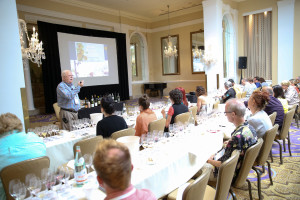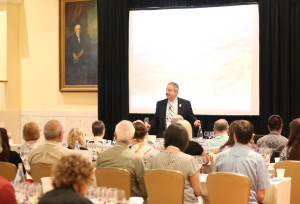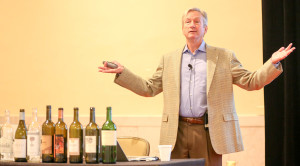The following sessions were enjoyed by all on Saturday morning, August 13, 2016 as part of SWE’s 40th Annual Conference, held at the Mayflower Hotel in Washington DC!
Get Your Teutonic On, presented by Hoke Harden, CSW, CSE: The beginnings of the word Teutonic, as well as the people described by the word may be a bit hazy, but the term is used today to refer to the culture surrounding Germany and central Europe–particularly those that speak German. This covers a wide range of fascinating spirits, beers, and wines–many of which were enjoyed by the attendees of this session!
The tastings began with a unique wine known a Punkt Genau. Punkt Genau is a sparkling Grüner Veltiner from the Weinviertel region of Austria—delicious. This was followed by Stiegl Radler, an Austria beer-fruit juice concoction produced in Salzburg. Other fascinating wines in the line-up included Tramin Lagrein from Italy’s Alto Adige, Markowitsch Rosé from Austria’s Carnuntum region, and Schoffit Chasselas 2012 Vin d’Alsace.
The countries of central Europe are well-known for their spirits, as evidenced by a tasting of Blume Marillen Apricot Eau-de-Vie, Nux Alpina Walnut Liqueur, and Zirbenz–an Austrian product known as the “Stone Pine Liqueur of the Alps.” For more information on getting your Teutonic on, click here to download the slide show from the session: Get Your Teutonic On – presented by Hoke Harden, CSW, CSE
Ancient Vines, Modern Wines, presented by Ed Korry, CSS, CWE: Greece is not only known for being the cradle of viticulture and winemaking, but it is currently the 16th largest wine-producing country in the world. A combination of culture, climate, and soils–including sand from the seas and volcanic soils on the islands–contributes to the high quality and diversity of the modern wines from Greece.
This session presented the 20 main grape varieties used in Greek wines, and offered up tastings based on wine region. The first wine tasted, from Peloponnese region, was Tselepos Amalia Brut, a delicious and unique sparkling wine produced from Moschofilero grapes. This was followed by Pepagiannakos Savatiano 2014. Savatiano is a thick-skinned white grape that is mainly known for its use in Retsina, but this wine from the Markopoulo PGI was crisp and clean. The next set of wines highlighted white grape varieties of Roditis, Malagousia, Robola, and Assyrtiko (from Santorini).
A set of red wines began with Skouras Grande Cuvée, a 100% Agiorgitiko produced from grapes grown in the Peloponnese and (more specifically) Nemea regions. This was followed by wine produced using the Limniona and Xinomavro grape varieties and a red blend from the Rapsani PDO. To wrap it up, a sweet Muscat-based wine, Samos Nectar was poured. To learn more about the wines of Greece and the wines poured during the seminar, download the session slide show here: Ancient Vines, Modern Wines-presented by Edward Korry, CWE, CSS
A Current Overview of Virginia Wines, presented by Jay Youmans, MW: It all began in the 1600’s, when settlers in Jamestown hoped that the colony of Virginia would become a major source of wine for the British Empire. We all know that didn’t quite turn out as planned, despite the exemplary efforts of the third President of the United States, Thomas Jefferson, at his Monticello Estate.
Thing began to improve in the late 1800’s, and in 1873 the world began to take notice of Virginia wines when a Virginia Norton (Vitis aestivalis) wine was named the “Best Red Wine of All Nations” at the Vienna World’s Fair. Today, Virginia has seven AVAs, over 280 bonded wineries and is the 7th largest producer of vinifera grapes in the nation. The leading grape varieties include Chardonnay, Viognier, Cabernet Franc, Merlot, and Cabernet Sauvignon. Other notable vinifera grapes include Petit Manseng and Petit Verdot.
Starting with Thomas Jefferson, some famous people helped to shape the Virginia wine industry. Modern-day celebrities involved in Virginia wine include the very popular Dave Matthews (of the Dave Matthews band fame) and the inimitable Donald Trump (and family). Leading winemakers involved in the growth of Virginia wines include Giani Zonin (of Casa Vinicola Zonin in Italy’s Veneto) who planted vineyards at Barboursville Vineyards in the 1970’s, and Dennis Horton (Of “Horton’s Norton” fame) who began his winemaking venture with a small home vineyard in Madison County, Virginia in 1983.
The wines tasted during the session included Michael Shaps 2014 Petit Manseng, Barboursville Vineyards 2015 Vermentino, Sunset Hills Petit Verdot and Keswick Vineyards 2014 Estate Cabernet Franc Reserve. For more information on the wines of Virginia, click here to download the slideshow from the session:A Current Overview of Virginia Wines-presented by Jay Youmans, CWE, MW
We will be posting additional conference recaps in the next few days. In addition, we are building our permanent archive of notes from the 2016 SWE Conference-click here! If you are a conference speaker who would like to share your materials, please contact Jane A. Nickles at jnickles@societyofwineeducators.org


